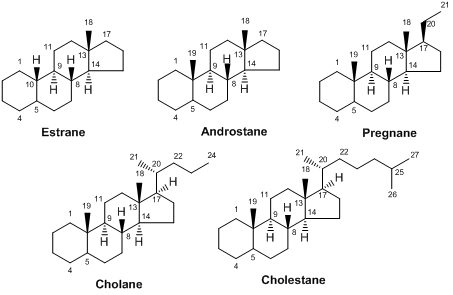TCI使用Cookie來個性化和改善您的用戶體驗,您可以訪問我們的私權政策 了解更多信息。
Notice of Discontinuing the Use of Password-Protected Compressed Files|Product Document Searching Made Easy by 2D Code! | TCI Chemistry News November 2024 | [Product Highlights] Hypervalent Iodine Reagent... | Various analytical charts can be searched on each product detail page and Product Document Search (The kinds of analytical charts differ by product)
臺幣價格即日起上線!
Maximum quantity allowed is 999
请选择数量
Steroids
Steroids are compounds consistuted of four fused rings, for example, the most common and best known steroid in humans, cholesterol. In animals, steroids are biosynthesized from lanosterol and are widely distributed. The distinctive feature in steroids is lack of methyl group at C-4 position as compared to terpenes. In this section, we have classified steroids into five basic categories based upon their chemical composition (Fig.1). Vitamin D, another steroid derivative, is described on "Vitamins".

• Steroid Hormones: Estranes, Androstanes, Pregnanes
Certain kinds of steroids like estrogenes, androstanes and pregnanes can act as hormones, their activities being closely related to their structures (Table 1). Pregnane-type steroids can be classified into corticoids and progestogens based on their bioactivities. Their classification and the typical compounds in each category are illustrated as follows:
Estrogens: Estrogens function as the primary female sex hormone and in combination with synthetic progestogens can be used as oral contraceptives to suppress ovulation. Recently, it is also reported that they are effective for the prevention of osteoporosis, heart attacks and Alzheimer’s disease in women.
Androgens: Testosterone is not only the principal and most well known male sex hormone but is also known to exert anabolic effects. This is also the main reason why some of them have been banned from use as bone density enhancers and muscle-building drugs by several sports organizations. They are also the intermediates of estrogene biosynthetic pathway or rather the precursors of all estrogens.
Progestogens: The only naturally occuring progestogen, i.e., progesterone, exhibits antiovulatory action. Based on its structure, derivatives of 19-nortestosterone were synthesized and can be used as oral contraceptives.
Corticoids: Synthetic corticoids such as dexamethasone and prednisolone find clinical use as anti-inflammatory agents. They are synthetically developed based on the structure of cortisone, a natural corticoid.
WARNING
Some of the steroid hormones may cause serious physiological actions. To avoid inhalation and contacting with skin, wear protective goggles, mask and eyeglasses when handling. Sufficient caution should be taken, when using these compounds, from the opening up to the disposal of the reagents.

• Bile Acids: Cholanes
Cholane type steroids are predominantly found in the bile. Cholic acid and its derivatives exist in bile as the major component as conjugates of glycine and taurine. Since conjugated cholates are amphiphilic, they assist in the digestion and absorption of lipids in small intestine. This characteristic is also exploited also in its use as a surfactant.
• Cholesterol: Cholestanes
Cholesterol possesses a cholestane-type skeleton and in conjugation with fatty acids, it forms the main component of cell membranes in animals and microorganisms. These cholesterol conjugates establish and maintain proper membrane permeability. In addition, it is a precursor of steroids as mentioned above and also exists in its liberated form in organisms.
• Phytosteroids, Steroid Glycosides, Other Steroids
Steroids of plant origin have different biosynthetic pathways: they are synthesized from cycloartenol. They possess structural features distinct from animal steroids, for instance, a characteristic alkyl side-chain at C-24. Steroid glycosides and their aglycones are also listed in this section.
Cholane type steroids are predominantly found in the bile. Cholic acid and its derivatives exist in bile as the major component as conjugates of glycine and taurine. Since conjugated cholates are amphiphilic, they assist in the digestion and absorption of lipids in small intestine. This characteristic is also exploited also in its use as a surfactant.
• Cholesterol: Cholestanes
Cholesterol possesses a cholestane-type skeleton and in conjugation with fatty acids, it forms the main component of cell membranes in animals and microorganisms. These cholesterol conjugates establish and maintain proper membrane permeability. In addition, it is a precursor of steroids as mentioned above and also exists in its liberated form in organisms.
• Phytosteroids, Steroid Glycosides, Other Steroids
Steroids of plant origin have different biosynthetic pathways: they are synthesized from cycloartenol. They possess structural features distinct from animal steroids, for instance, a characteristic alkyl side-chain at C-24. Steroid glycosides and their aglycones are also listed in this section.
References
- P. M. Dewick, in Medicinal Natural Products, 3rd ed., John Wiley & Sons, Chichester, 2009, pp. 247-298.